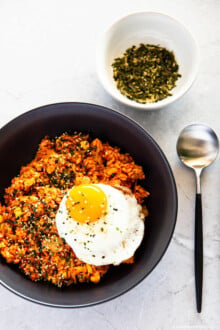The ultimate Korean comfort food – Kimchi Jjigae recipe!
Kimchi jjigae (김치찌개), or kimchi stew, is hands down one of the best ways to enjoy some properly aged kimchi. It’s such a household staple in Korea that many families will have it on the table at least once or twice a week, if not more. It’s hearty, cozy, and bursting with bold flavors that instantly warm you up.

Personally, I love making kimchi jjigae with fatty pork—it’s my absolute favorite! Sure, you can use other proteins like beef or canned tuna, and they work well too. But trust me, there’s something magical about how the pork fat melts into the broth. It transforms the dish into something extra rich and mouthwatering, beyond your average kimchi stew.
Honestly, for me, a bowl of this stew is all I need. Pair it with a serving of fluffy white rice, and that’s it—no side dishes required. It’s that satisfying. If you haven’t tried it yet, you absolutely need to. Once you do, you’ll understand why it’s a Korean classic!
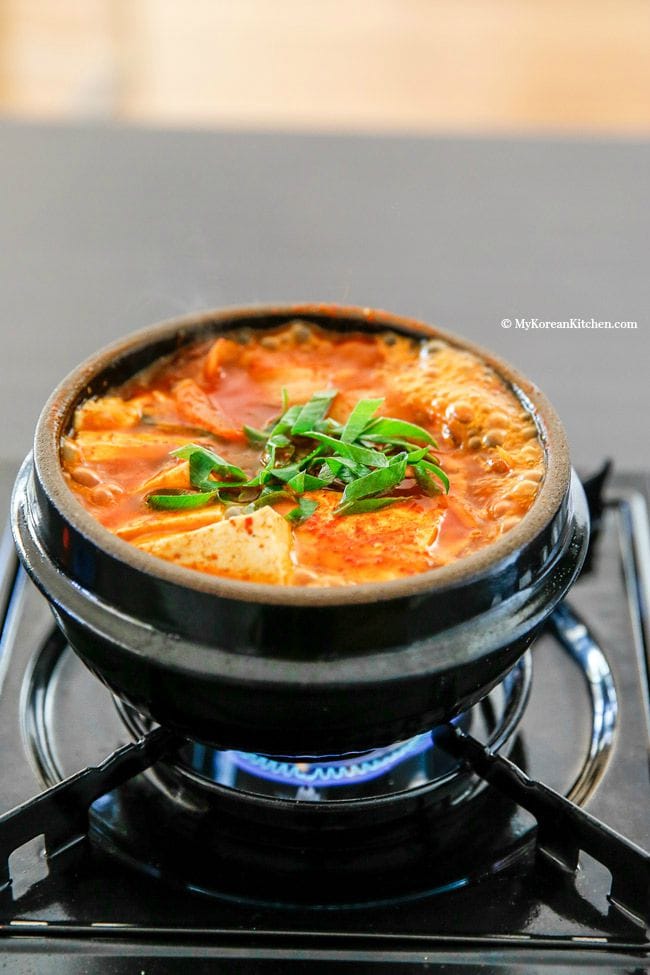
Ingredients
Meat
- 180g (0.4 pounds) skinless pork belly, cut into bite size pieces
- 1 Tbsp rice wine, sweet (mirin)
- 3 sprinkles ground black pepper
Kimchi & Others
- 3/4 cup aged (at least 2 to 3 weeks old) kimchi, cut into bite size pieces if not already
- 1/4 small (30g, 1 ounce) brown onion, thinly sliced
- 1/2 stalk small (5g, 0.2 ounce) green onion, thinly sliced
- 2 small (50g, 1.4 ounces) shiitake mushrooms, stems removed, thinly sliced
- 150g (5.3 ounces) firm tofu, sliced into 1cm (0.4 inch) thickness rectangle (or other shapes you may prefer)
- 1 cup water
Jjigae Base (Mix these in a bowl)
- 1 Tbsp Korean chili flakes (gochugaru)
- 1 Tbsp soy sauce
- 1 tsp Korean chili paste (gochujang)
- 1/4 tsp minced garlic
- 3 sprinkles ground black pepper
* 1 Tbsp = 15 ml, 1 Cup = 250 ml
** If you’re not sure of the above Korean cooking ingredients, look them up from my essential Korean Cooking Ingredients post.
How to Make Kimchi Jjigae (Kimchi Stew)
1. Marinate the pork belly with the rice wine and the ground black pepper for about 15 mins.

2. Cook the kimchi in a skillet until soft. (Alternatively, you can do this directly in the pot where you’ll make the jjigae, but only if the pot is large enough to maneuver easily.)
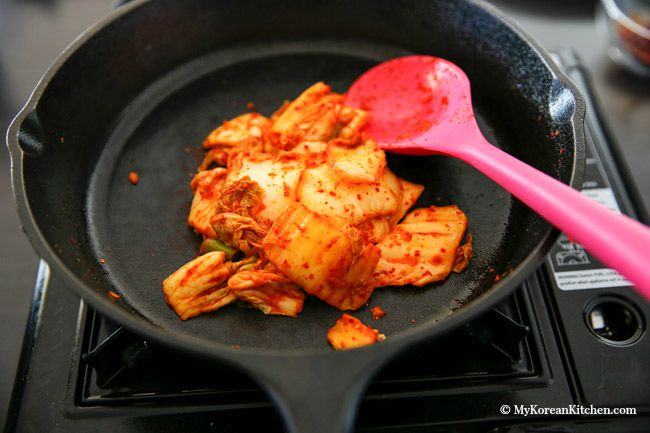
3. Place the marinated meat at the bottom of the pot. Add all the other ingredients—kimchi, onion, mushrooms, tofu, water, and the base sauce—into the pot, except for the green onion. (I used a clay pot with a capacity of just over 1 liter. I’ve also successfully made this using an 18cm (7-inch) Staub Cocotte without needing the skillet mentioned in the previous step.)
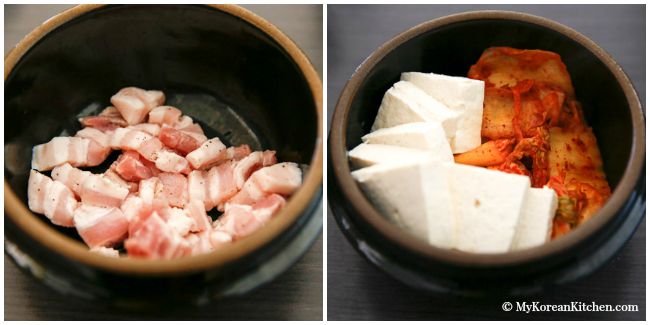
4. Bring the pot to a boil over medium-high heat. Once boiling, lower the heat to medium and continue cooking until the meat is completely cooked through, which should take about 10 to 15 minutes from the start of this step. To ensure the sauce is evenly incorporated, gently stir it into the soup using a spoon. Occasionally, spoon some of the broth over the other ingredients to help distribute the flavors. When the meat is done, add the green onion, give it a final gentle mix, and turn off the heat.
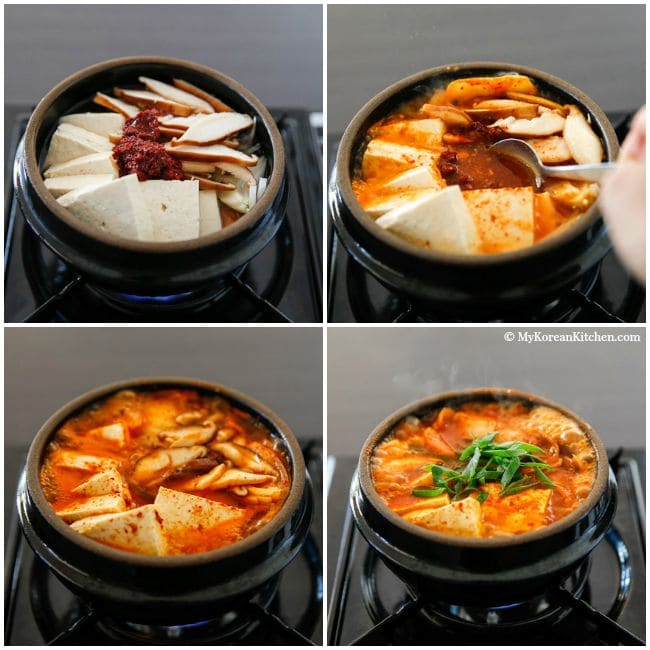
5. Serve with a bowl of rice and other Korean side dishes.

Two Delicious Kimchi Stew Variations
If you’re craving beef in your stew, give this Slow Cooker Kimchi Stew with Beef a try. It’s incredibly easy to prepare and delivers amazing flavor with minimal effort. Just set it and forget it, and you’ll end up with a hearty, comforting meal that’s sure to satisfy.
For a lighter twist, try the Kimchi Soup with Canned Tuna. It’s bold and flavorful yet light and refreshing—the perfect choice when you want something wholesome without feeling too heavy.
Other Recipes Using Kimchi
Do you love kimchi? Or you simply have too much in your fridge, and you’re not quite sure what to do? Don’t worry—I’ve got you covered! Here are a few fun and delicious ways to transform your kimchi into something amazing:
- Kimchi Pancake: Crispy, savory, and loaded with flavor—perfect for a quick snack or appetizer.
- Kimchi Fried Rice : A simple yet satisfying dish that’s bursting with bold, tangy goodness.
- Kimchi Dumplings: Bite-sized parcels of pure joy, ideal for steaming or pan-frying.
Not tempted by these? Don’t fret! Check out my post on how to eat kimchi, where you’ll find 11 more creative and mouthwatering ways to enjoy your kimchi stash. You’re bound to discover a new favorite!
Discover More! Explore our site for authentic Korean recipes—from mastering the art of perfect Korean BBQ at home to creating delicious banchan (Korean side dishes) and other tasty, easy Korean dishes. Let us inspire your next meal!
How I Make It: Step-by-Step Recipe Video

Kimchi Jjigae Recipe - Authentic Korean Stew for Ultimate Comfort Food
Ingredients
Meat
- 180 g skinless pork belly (0.4 pounds), cut into bite size pieces
- 1 Tbsp rice wine , sweet (mirin)
- 3 sprinkles ground black pepper
Kimchi & Others
- 3/4 cup aged Kimchi (at least 2 to 3 weeks old), cut into bite size pieces if not already
- 1/4 small brown onion (30 g / 1 ounce), thinly sliced
- 1/2 stalk small green onion (5 g / 0.2 ounce), thinly sliced
- 2 small shiitake mushrooms (50 g / 1.4 ounces), stems removed, thinly sliced
- 150 g firm tofu (5.3 ounces), sliced into 1cm thickness rectangles, or other shapes you may prefer
- 1 cup water
Jjigae base (mix these in a bowl)
- 1 Tbsp Korean chili flakes (gochugaru)
- 1 Tbsp soy sauce
- 1 tsp Korean chili paste (gochujang)
- 1/4 tsp minced garlic
- 3 sprinkles ground black pepper
Instructions
- Marinate the pork belly with the rice wine and the ground black pepper for about 15 mins.
- Cook the kimchi in a skillet until soft. (Alternatively, you can do this directly in the pot where you’ll make the jjigae, but only if the pot is large enough to maneuver easily.)
- Place the marinated meat at the bottom of the pot. Add all the other ingredients—kimchi, onion, mushrooms, tofu, water, and the base sauce—into the pot, except for the green onion. (I used a clay pot with a capacity of just over 1 liter. I’ve also successfully made this using an 18cm (7-inch) Staub Cocotte without needing the skillet mentioned in the previous step.)
- Bring the pot to a boil over medium-high heat. Once boiling, lower the heat to medium and continue cooking until the meat is completely cooked through, which should take about 10 to 15 minutes from the start of this step. To ensure the sauce is evenly incorporated, gently stir it into the soup using a spoon. Occasionally, spoon some of the broth over the other ingredients to help distribute the flavors. When the meat is done, add the green onion, give it a final gentle mix, and turn off the heat.
- Serve with a bowl of rice and other Korean side dishes.
Notes
Nutrition Info (per serving)
The nutrition information shown is an estimate provided by an online nutrition calculator. It should not be considered a substitute for a professional nutritionist’s advice.



